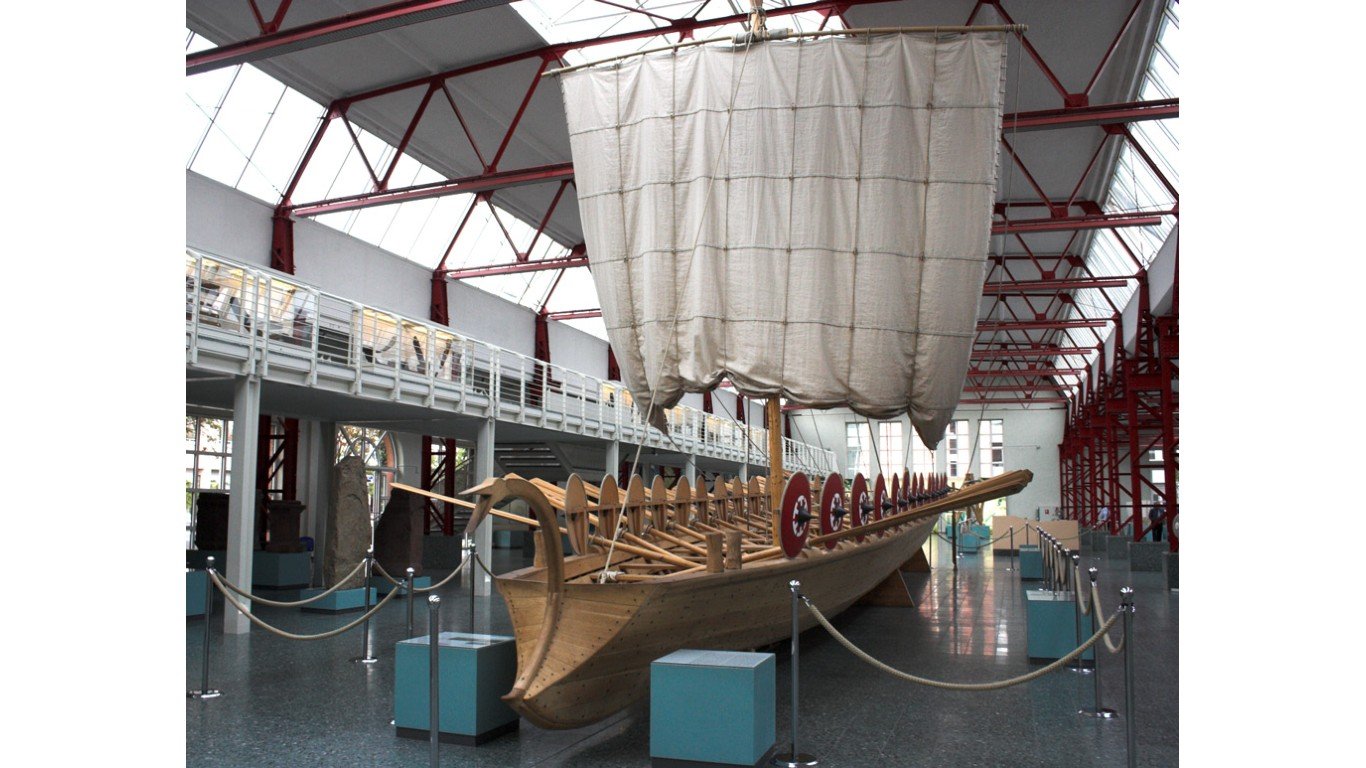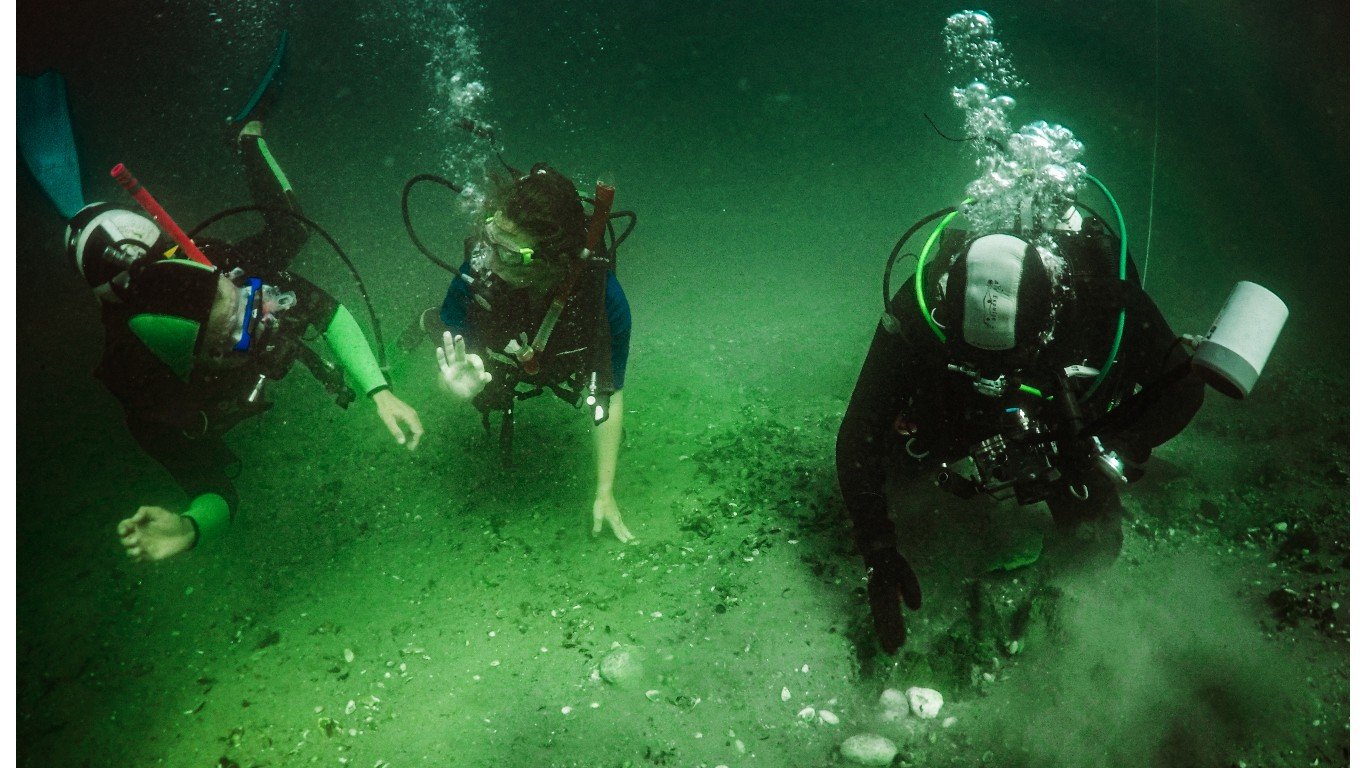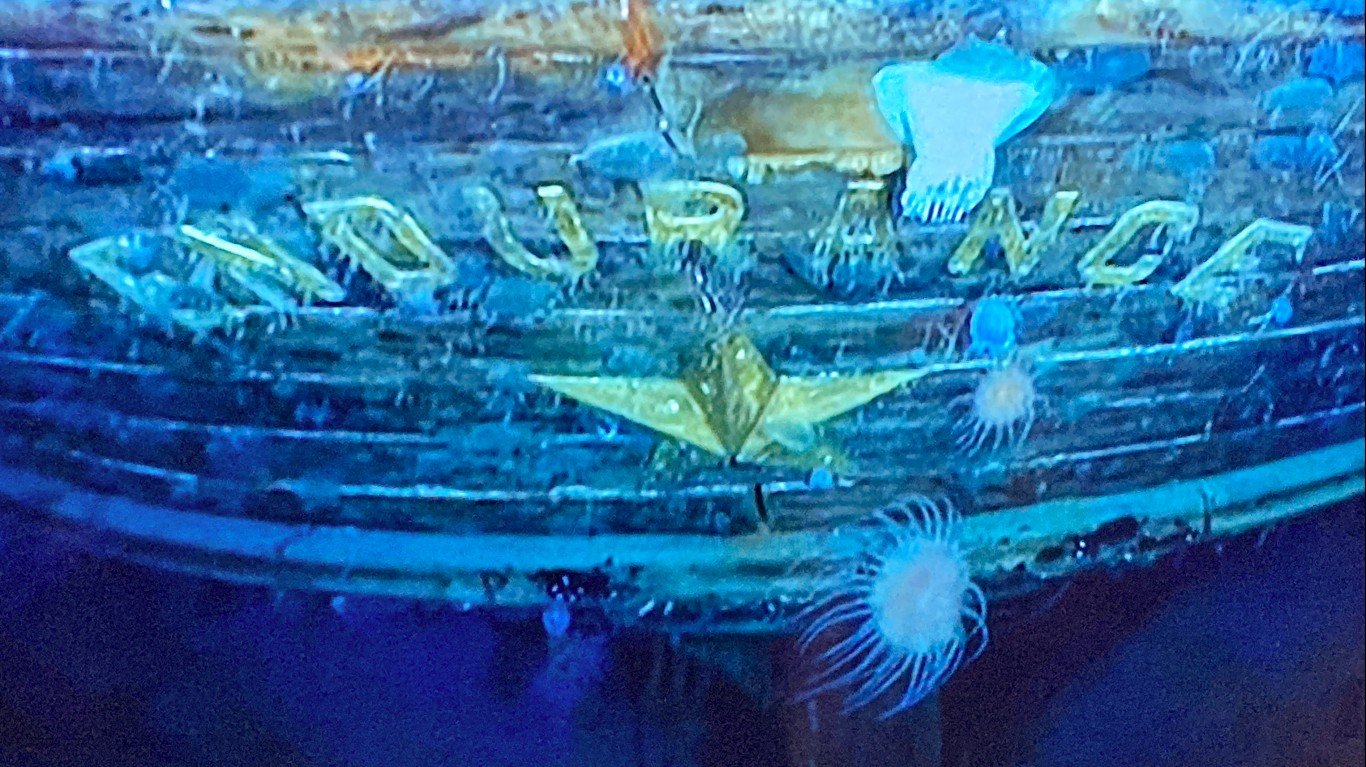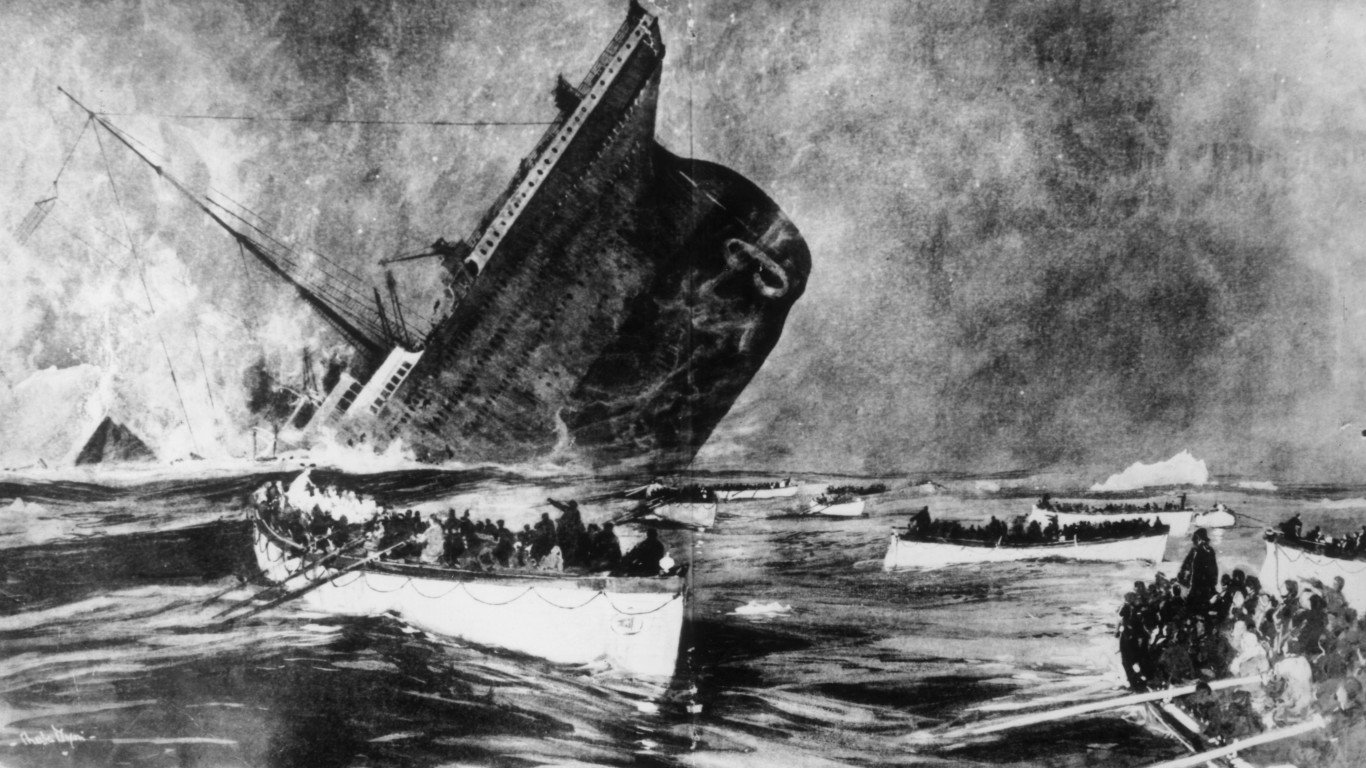

Finding a shipwreck has been the stuff of fantasy for as long as people have sought opportunities beyond the horizon. There is no shortage of wrecked vessels to find; it’s estimated that there are more than three million undiscovered shipwrecks around the world.
While explorers such as Jacques Cousteau have long stirred imaginations with underwater probes of doomed vessels, interest in shipwrecks soared in 1985 when professor of oceanography and maritime archeologist Robert Ballard found the most famous shipwreck of all – RMS Titanic. Since then, there’s been an explosion of shipwreck finds around the world. (These are 57 fascinating facts about the Titanic.)
To compile a list of shipwrecks found since the discovery of the Titanic, 24/7 Tempo gleaned information from sources such as Guernsey Museums, Naval History and Heritage Command Marine Insight, UNESCO, History, and Archaeology Mysteries, as well as various media websites.
David Mearns, who discovered a few of the notable shipwrecks on this list, told History that there are several reasons for the uptick in finding sunken vessels. Records around the world have been digitized, making them more easily accessible and explorers have better tools for searches. These include autonomous underwater vehicles, or AUVs, and remote operated vehicles, or ROVs, which allow explorers to probe almost any ocean depth and to cover a wider area than had previously been practical. (Here are the most famous shipwrecks ever found.)
Since the Titanic was found, shipwreck hunters have discovered ships battered by hurricanes like the SS Central America, which contained gold from the 1849 Gold Rush; vessels from the fleets of the Spanish Armada, Vasco da Gama, LaSalle, and Kublai Khan; the world’s oldest intact boat lying off the Bulgarian coastline; and many World War II-era ships sunk in battle, some of them found by the research team of Microsoft co-founder Paul Allen.
Click here to see 29 shipwrecks found since the discovery of the Titanic
The most recent significant discovery came in early March 2022, when researchers and maritime archeologists found the British vessel Endurance, the lost ship of Antarctic explorer Sir Ernest Shackleton, that was crushed by sea ice and sank in 1915.
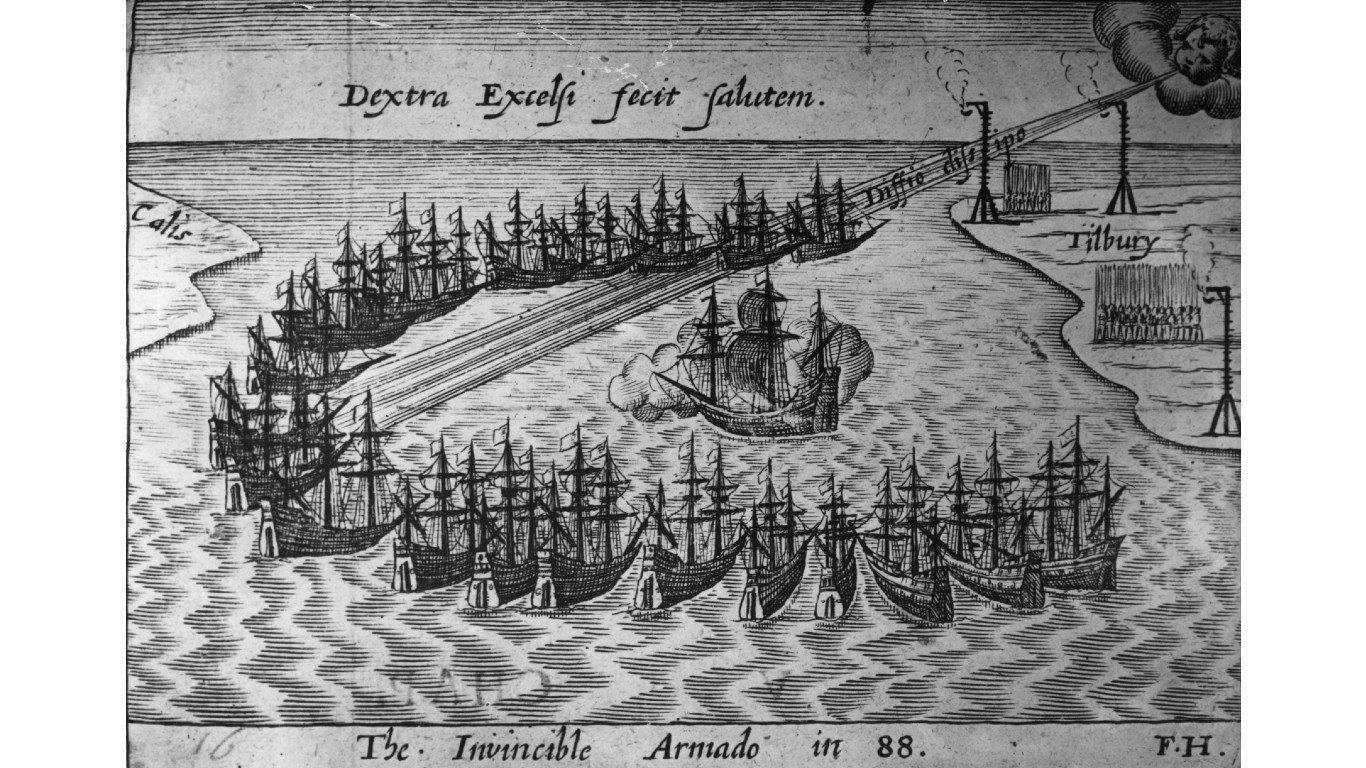
1985: Ships from Spanish Armada
> Year lost: 1588
> Location where found: Off the Scottish and Irish coasts
> Found by: Local British divers
You might recall from your grade-school history books that the Spanish Armada, sent by Spain to invade England in 1588, encountered raging storms off the coasts of Scotland and Ireland. Ships foundered, killing 5,000 Spaniards. In 1985, local divers discovered the wrecks of three vessels of the doomed fleet – La Lavia, La Santa María de Visión, and La Juliana. Thirty years later, several cannons from La Juliana were found off the Irish coast.
[in-text-ad]
1985: Nuestra Señora de Atocha
> Year lost: 1622
> Location where found: Off the Florida coast
> Found by: Treasure hunter Mel Fisher
Famed treasure hunter Mel Fisher hit the jackpot in 1985 when he discovered this Spanish merchant ship off the Florida coast. The ship was one of at least eight vessels lost in a hurricane in 1622 that sent to the bottom cargo worth more than $450 million today. The ship contained 40 tons of gold and silver and around 70 pounds of Colombian emeralds. The discovery ended Fisher’s quest for the ship, which had begun in 1969.
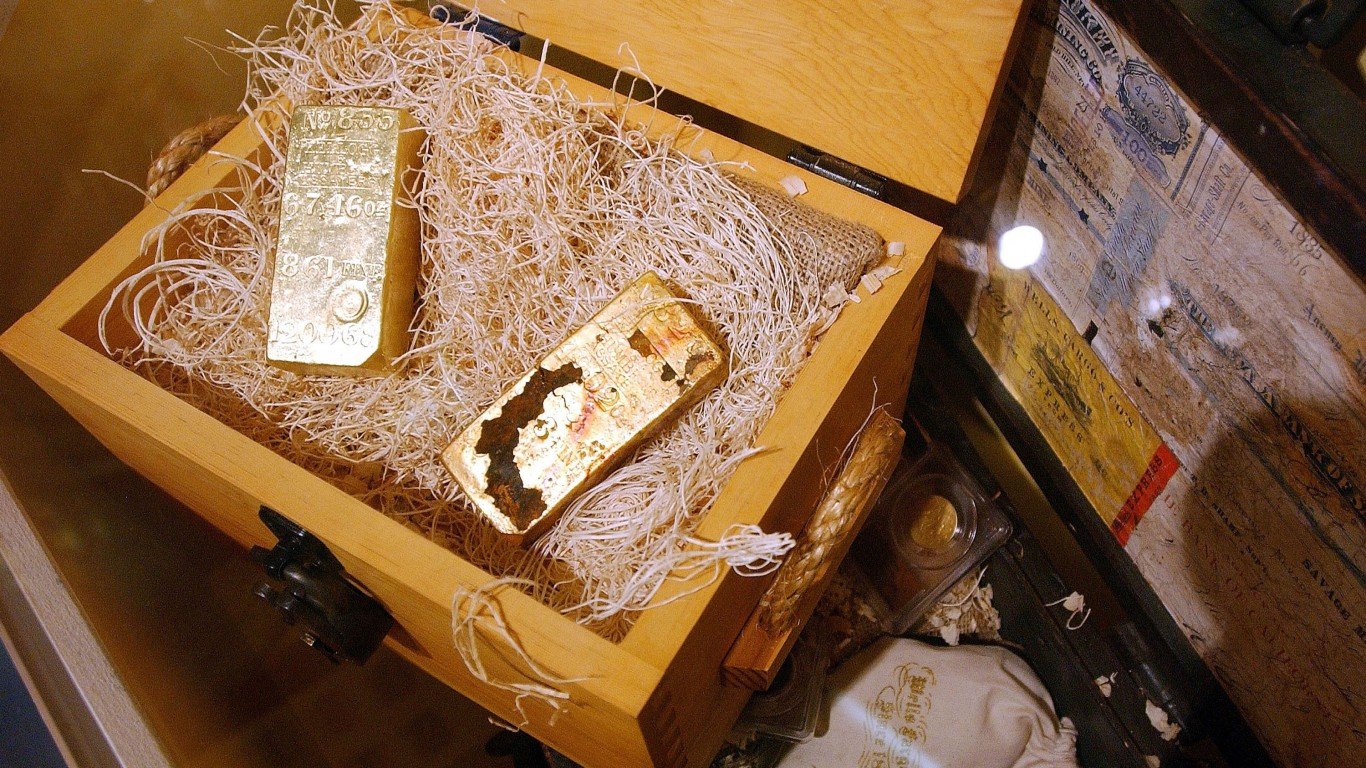
1988: SS Central America
> Year lost: 1857
> Location where found: Off the South Carolina coast
> Found by: Columbus-America Discovery Group
The SS Central America, bearing 477 passengers and almost 10 tons of gold discovered in California during the 1849 Gold Rush, was bound for New York City from Panama when it was struck by a hurricane off the coast of South Carolina. The shipwreck was discovered in 1988 along with $150 million worth of gold. The find triggered a complex legal case involving research scientist Tommy Thompson who claimed not to know the whereabouts of the haul, enraging his investors. Thompson refused to cooperate with authorities and was jailed for contempt.
[in-text-ad-2]
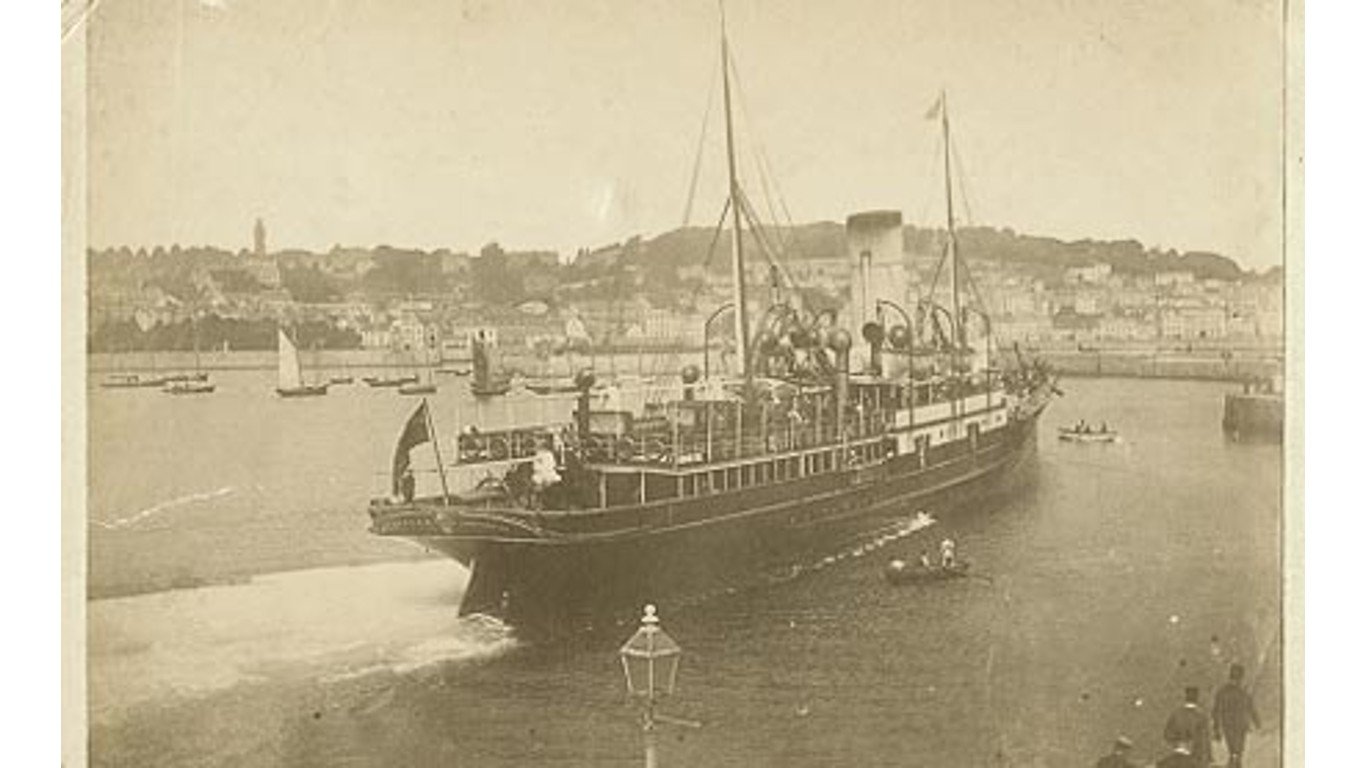
1991: Stella
> Year lost: 1899
> Location where found: Channel Islands coast
> Found by: Jersey Sub-Aqua Club
The Stella was a steamer put into service in 1890 to ply the route between the English mainland and the Channel Islands. It was sailing at 18 knots when a thick fog descended. The crew thought they were farther out from the Casquets, a dangerous rocky reef with lighthouses used by mariners for the turning point to Guernsey. The shoals tore the bottom out of the hull, and the vessel sank in eight minutes; 105 passengers and crew lost their lives. In 1991, John Ovenden, an amateur diver from Jersey, and a team of divers from Jersey Sub-Aqua Club found the wreck.
1994: Ships from fleet of Kublai Khan
> Year lost: 1274 or 1281
> Location where found: Imari Bay off the coast of Takashima, Japan
> Found by: Kenzo Hayashida, director of the Institute of Asian Research in underwater archaeology in Japan
After conquering Korea, the Mongol prince Kublai Khan made several attempts to conquer Japan with huge fleets of ships. One on sortie, in either 1274 or 1281, the fleet was thwarted by a large storm known as a “kamikaze” (“divine wind”) – a term later adopted by Japanese pilots who flew suiсide missions against Allied ships during World War II. The story of the great tempest has become a major part of Japanese folklore, but where were the ships? In 1994, a research team led by Kenzo Hayashida, director of the Institute of Asian Research in Underwater Archaeology in Japan, found three stone and wooden anchors in Kozaki Harbor, a small cove on the south coast of Takashima. Later that year, they found the remains of a ship in 45 feet of water. Hayashida was confident that this was a ship from the fabled fleet.
[in-text-ad]
1995: La Belle
> Year lost: 1686
> Location where found: Matagorda Bay off the coast of Texas
> Found by: Archaeologists from Texas Historical Commission
In 1684, the French ship La Belle and three other ships belonging to the famed explorer René-Robert Cavelier, known as La Salle, set sail from France for the Mississippi River with 300 settlers aiming to colonize the area, discover trade routes, and find Spanish silver mines. Some of the ships were lost to pirates and storms en route. The La Belle veered hundreds of miles off course into Matagorda Bay off the coast of Texas, where it sank during a storm in 1686. It was found in 1995 by marine archaeologists from the Texas Historical Commission. The hull has been recovered, along with artifacts including tools, trade goods, weapons, and personal items of the would-be settlers.
1996: Queen Anne’s Revenge
> Year lost: 1718
> Location where found: Beaufort Inlet off the North Carolina coast
> Found by: Private salvage company
Queen Anne’s Revenge had a complicated history. It was originally a Royal Navy vessel, it became a French slave ship, and then it was commandeered by the pirate Blackbeard in 1717. A year later, the ship ran aground in the Beaufort Inlet off the coast of North Carolina and Blackbeard escaped from the wreck. The ship was discovered in 23 feet of water by a private salvage company in 1996. More than 30 cannon and 250,000 artifacts have been removed from the wreck.
1998: Batu Hitam
> Year lost: 830
> Location where found: Off Belitung Island, Indonesia
> Found by: Local fishermen
Batu Hitam was an ancient Arabian dhow discovered in 1998 off the Indonesian coast by local fishermen. It was likely traveling from China to Africa along what was called the Maritime Silk Route when it sank, carrying what may be the largest collection of Tang Dynasty artifacts ever discovered – more than 60,000 pieces. Valued at about $90 million, the treasures recovered from the shipwreck are mostly ceramics and pottery, including bowls, spice jars, and funeral urns.
[in-text-ad-2]
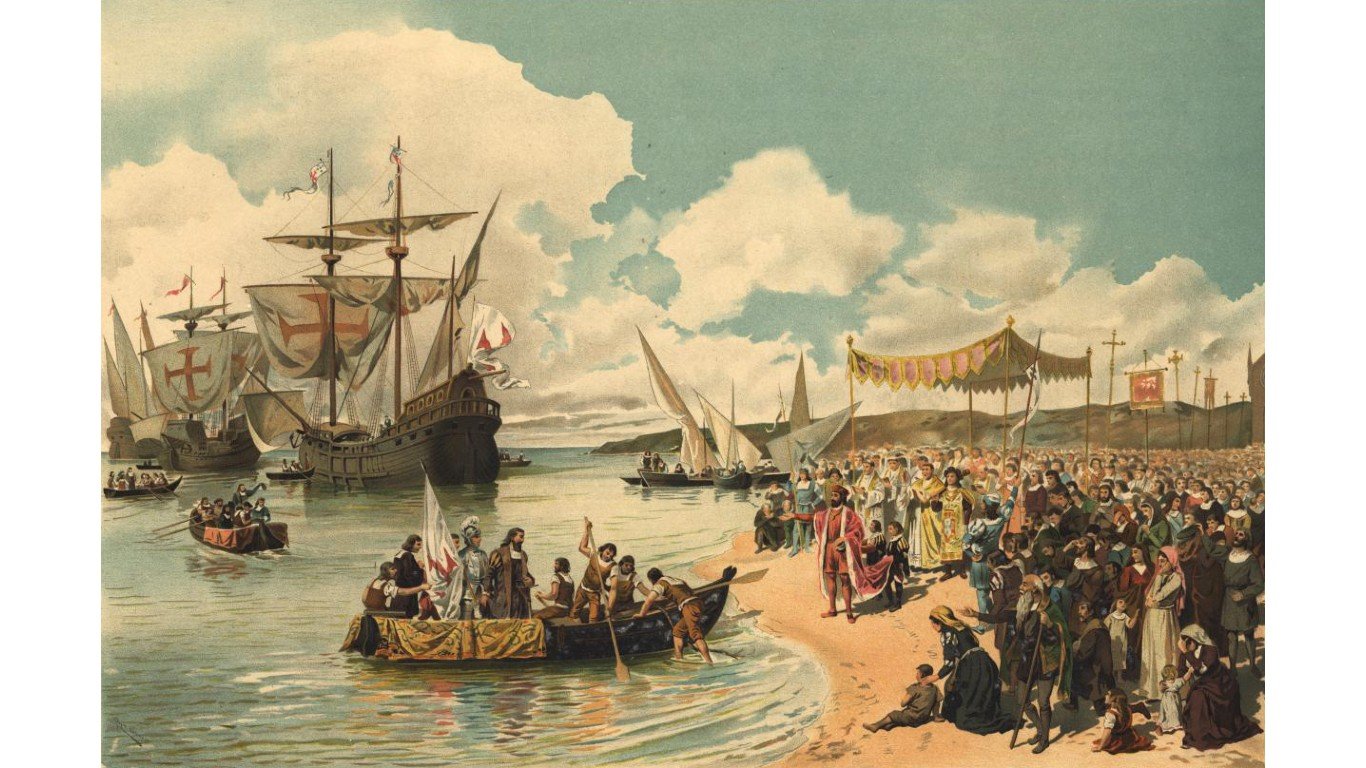
1998: Esmeralda
> Year lost: 1503
> Location where found: Off the coast of Oman
> Found by: Team led by David Mearns
The shipwreck believed to be the Esmeralda, part of the fleet of famed explorer Vasco da Gama, was found off the coast of Oman in 1998. It is considered to be the oldest wreck discovered from the Age of Discovery. Among the artifacts found were a ship’s bell, a Portuguese coin minted for trade with India, and stone cannonballs engraved with what appear to be the initials of Vincente Sodré, da Gama’s maternal uncle and the commander of the Esmeralda.
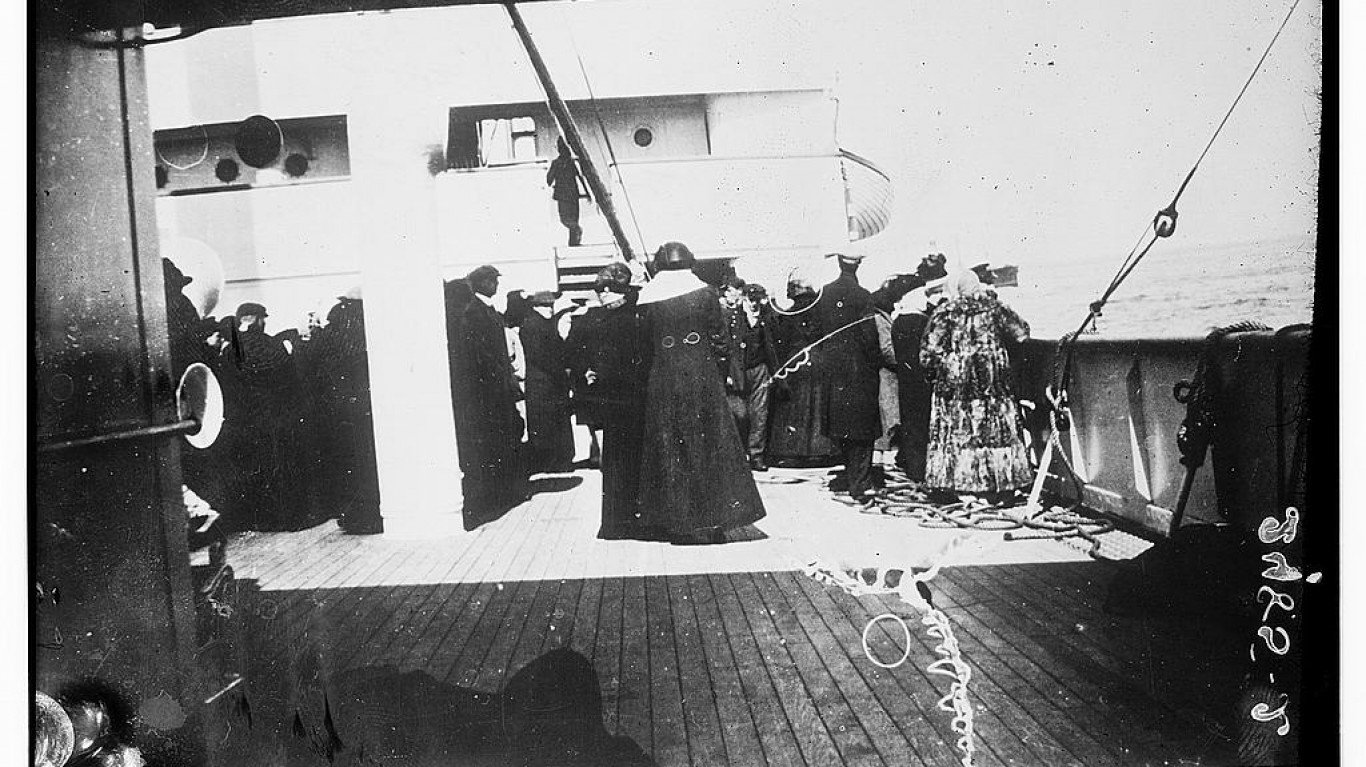
1999: RMS Carpathia
> Year lost: 1917
> Location where found: West of Land’s End
> Found by: Argosy International Ltd
The British passenger liner RMS Carpathia is remembered for rescuing survivors from the Titanic in 1912. Unfortunately, the ship would meet its own doom in World War I, when it was torpedoed by a German U-boat in 1917. The vessel was attacked as part of a convoy traveling from Liverpool to Boston and five people died. The wreck of Carpathia was found in 1999, by Argosy International Ltd., in 600 feet of water, about 185 miles west of Land’s End, England.
[in-text-ad]

2006: Graf Zeppelin
> Year lost: 1947
> Location where found: Baltic Sea
> Found by: Polish oil company
The Graf Zeppelin was Nazi Germany’s only aircraft carrier during World War II, though it was not put into service because construction was never completed. Germany scuttled the ship as the war was coming to an end. The Soviet Union raised it and then used it for target practice, sinking it in the Baltic Sea. A Polish oil company found it in 2006.

2007: Korean 12th-century shipwreck
> Year lost: 12th century
> Location where found: Off the South Korean coast
> Found by: South Korean archaeologists
In 2007, South Korean archaeologists discovered a huge cache of well-preserved Korean porcelain from a 12th-century shipwreck, after local fishermen caught an octopus clutching an ancient plate and reported the find to authorities. The collection includes over 2,500 cups, bowls, and plates intended to be delivered to government officials and nobles of the Goryeo Dynasty.
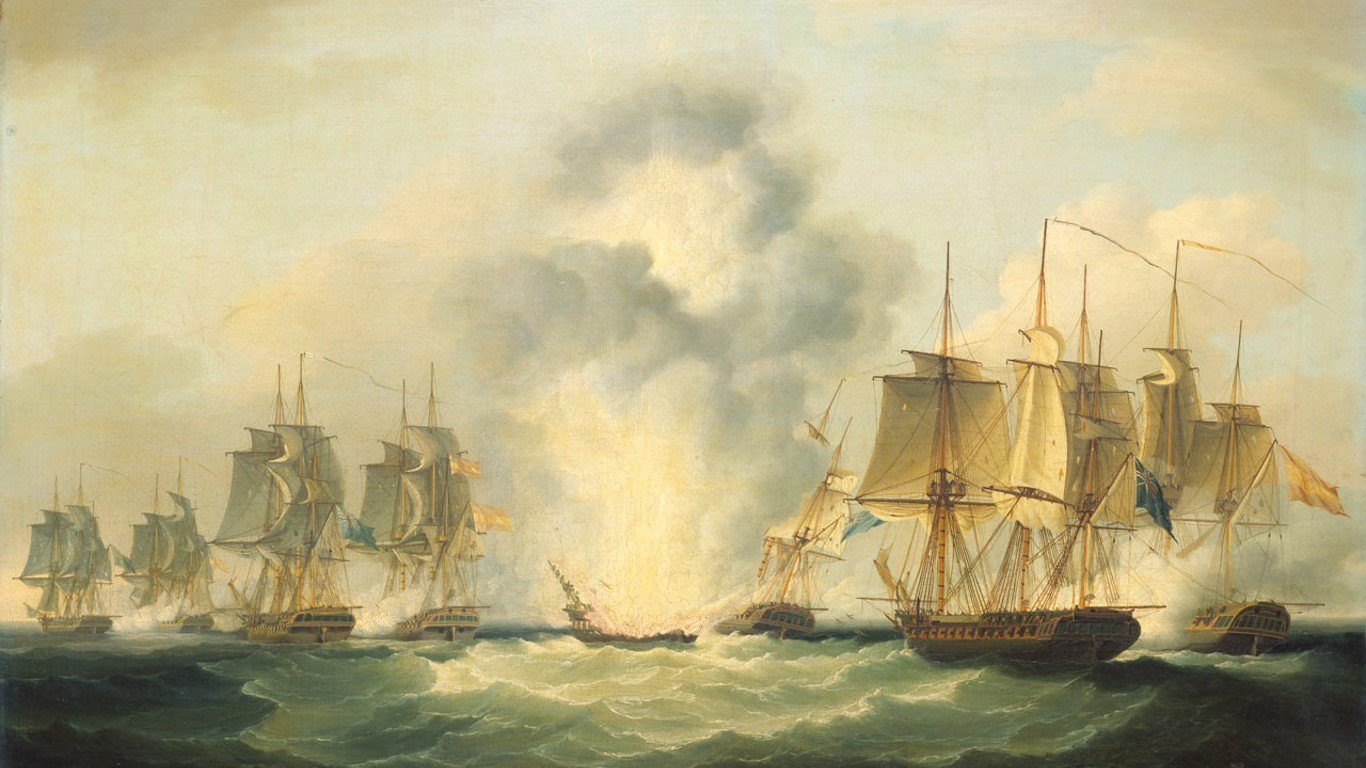
2007: Nuestra Señora de las Mercedes
> Year lost: 1804
> Location where found: Off the Portuguese coast
> Found by: Odyssey Marine Exploration
The Nuestra Señora de las Mercedes, a Spanish frigate sunk by the Royal Navy in 1804, is one of the most valuable shipwrecks ever discovered. About $500 million in gold has been recovered from the wreck, which was found off the coast of Portugal in 2007. The Spanish and Peruvian governments both claimed ownership of the gold, and in 2012 a U.S. Supreme Court ruling granted Spain the rights to the treasure. The gold, along with other artifacts from the shipwreck, is now on display in museums across Spain.
[in-text-ad-2]
2008: Two Brothers
> Year lost: 1823
> Location where found: Northwest of Honolulu
> Found by: Archaeologists working with NOAA’s Office of National Marine Sanctuaries
Captain George Pollard, whose ship the Essex was struck by a whale and sank in 1820 (it was an inspiration for “Moby Diсk”), lost another whaling vessel in a storm west of Hawaii in 1823. Pollard and his crew escaped and boarded their consort whaleship, Martha. The Two Brothers shipwreck was discovered 600 miles northwest of Honolulu in 2008 by archaeologists working with the National Oceanic and Atmospheric Administration’s Office of National Marine Sanctuaries. The shipwreck has been placed on the National Register of Historic Places.
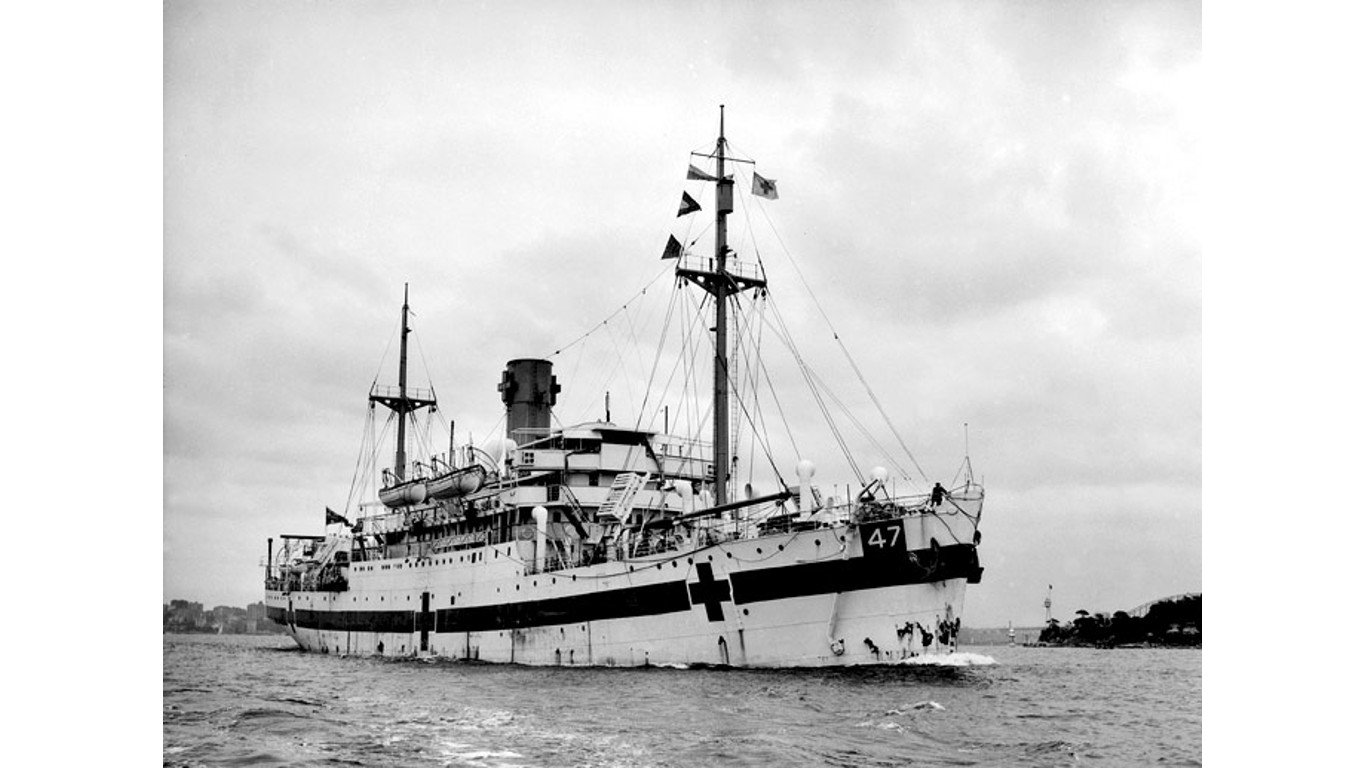
2009: AHS Centaur
> Year lost: 1943
> Location where found: East-north-east of Brisbane, Australia
> Found by: Search team led by led by David Mearns
The AHS Centaur, a clearly marked World War II Australian hospital ship traveling from Sydney to Port Moresby, was struck by a Japanese torpedo in 1943. Of the 332 passengers, 64 survived and were rescued by an American ship after waiting 35 hours on life rafts. Its sinking was considered an atrocity and the Australian Government lodged an official protest to Japan over the incident.The wreckage was discovered in 2009 by a research team led by David Mearns. The site is protected to prevent souvenir hunters from raiding the remains.
[in-text-ad]
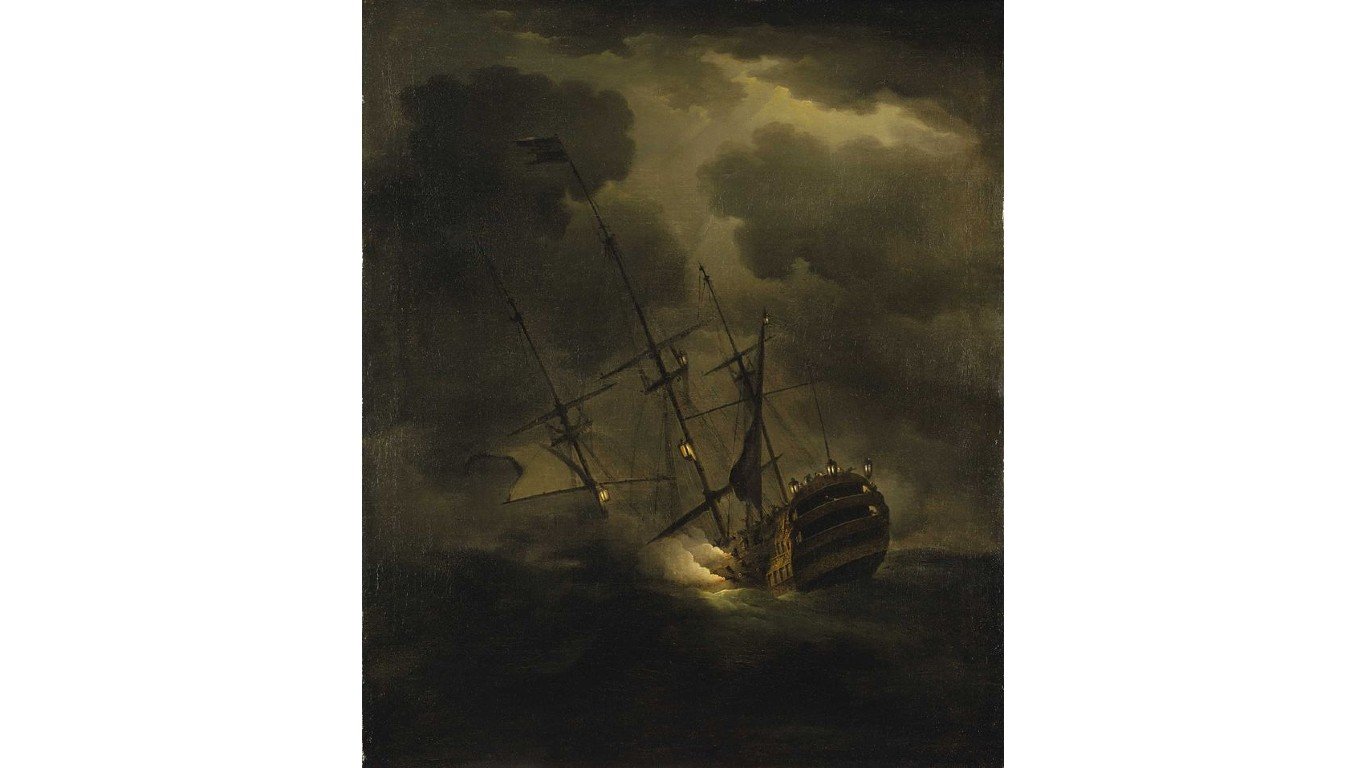
2009: HMS Victory
> Year lost: 1744
> Location where found: English Channel
> Found by: Odyssey Marine Exploration
The 100-gun ship of the Royal Navy HMS Victory, returning with its fleet from a mission against the French, was lost during a violent storm in the English Channel in 1744, claiming the lives of more than 1,000 sailors. The shipwreck was discovered in 2008 by the Odyssey Marine Expedition of the United States. The reasons for the Victory’s tragedy were poor ship design, top-heavy weight, instability caused by heavy guns, and possibly rotting timbers.
2011: Roman transport ship
> Year lost: 1st century B.C.
> Location where found: Off the Albanian coast
> Found by: Joint U.S.-Albanian archeological mission
A U.S.-Albanian archaeological team found the well-preserved 2,200-year-old wreck of a Roman cargo ship off Albania’s coast in 2011. The cargo contained 300 wine jars, believed to have contained the yield from southern Albanian vineyards bound for western European markets. The ship’s remains were found in 164-foot deep water near the port city of Vlorë.

2014: HMS Erebus
> Year lost: 1848
> Location where found: Off King William Island in the Canadian Arctic
> Found by: Canadian marine archeologists
While searching for the Northwest Passage, Royal Navy Officer John Franklin and all his crew, along with their two ships, disappeared in 1848. The fate of Franklin’s ships the HMS Erebus and HMS Terror remained a mystery for over 160 years, despite many attempts to find them. Then in 2014, a Canadian search mission found the Erebus in shallow water, almost fully intact, along with a note that said Franklin had died before the two ships were abandoned.
[in-text-ad-2]

2016: HMS Terror
> Year lost: 1848
> Location where found: Off King William Island in the Canadian Arctic
> Found by: Arctic Research Foundation
Two years after Canadian marine archeologists found its sister ship Erebus, the HMS Terror was discovered by researchers from the Arctic Research Foundation in about the same area. Both ships had been abandoned in 1848 because of heavy sea ice in their failed attempt to find the Northwest Passage. All 129 men on both ships died in the worst disaster to befall Britain’s Royal Navy in polar exploration.
2018: Black Sea shipwreck
> Year lost: 3rd century B.C.
> Location where found: 50 miles off of the Bulgarian coast
> Found by: Black Sea Marine Archeology Project
A vessel that sank more than 2,400 years ago, 50 miles off the coast of Bulgaria, was found in 2018 and is considered to be the oldest intact shipwreck ever found. The ship was discovered by the Black Sea Marine Archeology Project, an Anglo-Bulgarian research team. The merchant ship resembled a vessel that was depicted on ancient Greek wine vases. The ship remained so well-preserved because the more-than-mile deep environment in which it was found lacks oxygen.
[in-text-ad]

2018: USS Juneau
> Year lost: 1942
> Location where found: Off the Solomon Islands
> Found by: Team led by Microsoft co-founder Paul Allen
During the WWII Battle of Guadalcanal, the USS Juneau was sunk by a Japanese torpedo off the Solomon Islands, taking 687 people with it. Among the casualties were the five Sullivan brothers from Iowa. The Juneau was discovered in 2018 by Microsoft co-founder Paul Allen using his research vessel, the R/V Petrel.
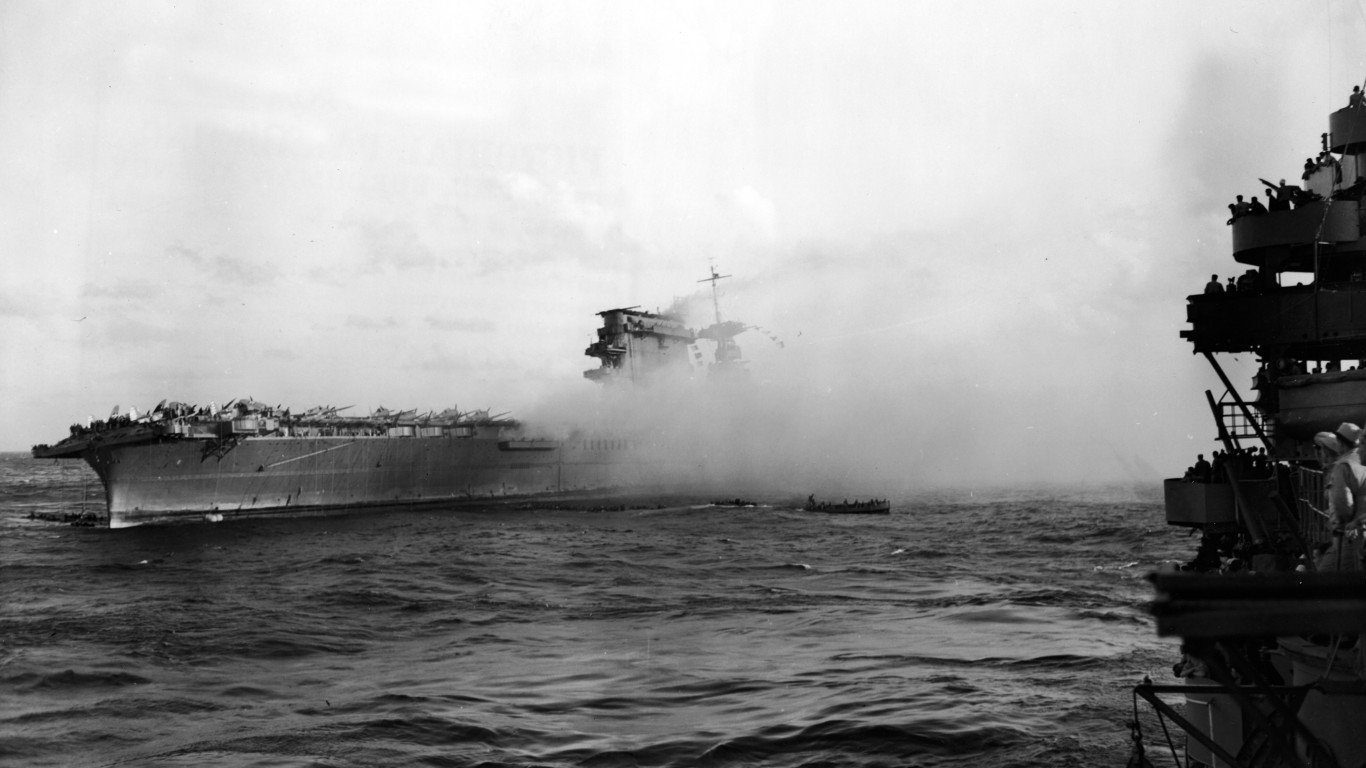
2018: USS Lexington
> Year lost: 1942
> Location where found: Coral Sea
> Found by: Team led by Microsoft co-founder Paul Allen
The USS Lexington, which was sunk during the Battle of the Coral Sea in May 1942, was found in 2019 by a research team led by Microsoft founder Paul Allen, using the research vessel the R/V Petrel. The Lexington, which was out at sea when the Japanese attacked Pearl Harbor in 1941, was originally conceived as a battlecruiser before it was redesigned to be one of America’s first operational aircraft carriers in 1922.
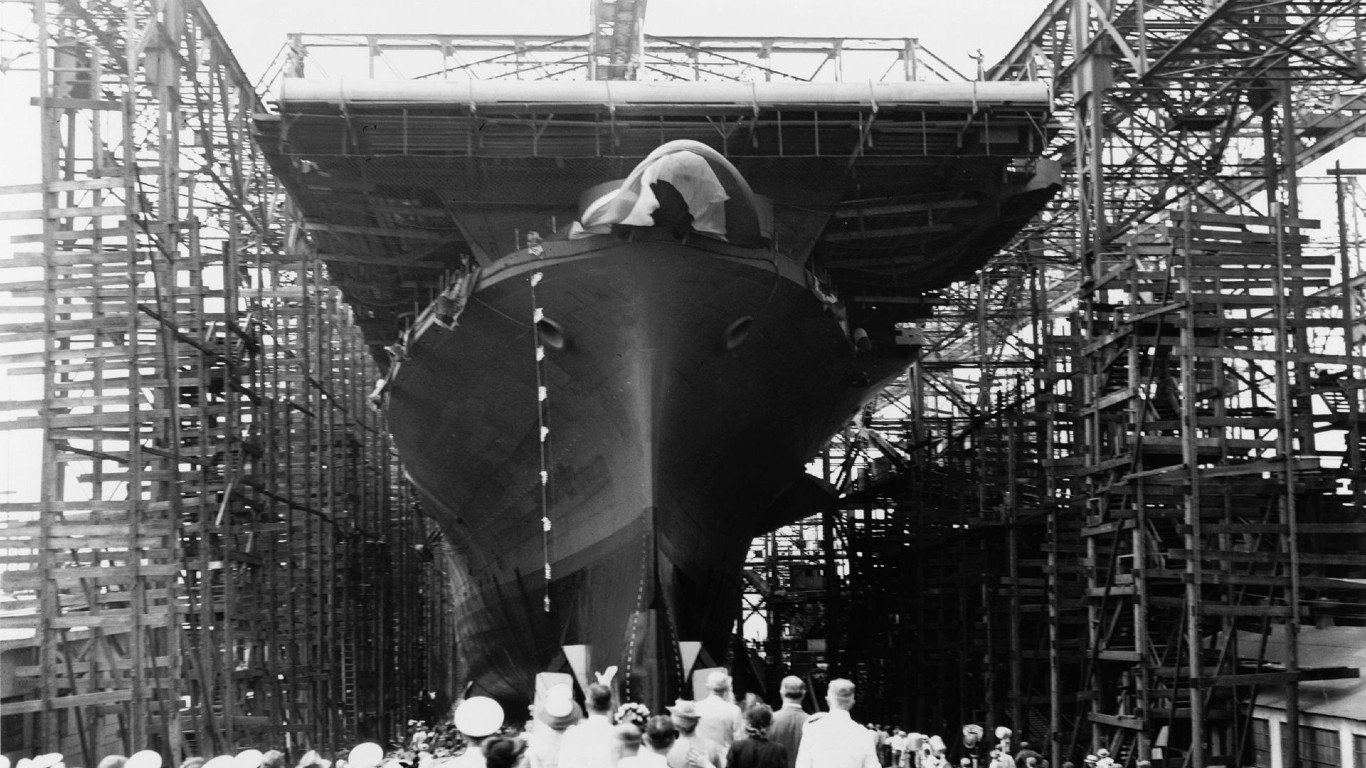
2019: USS Hornet
> Year lost: 1942
> Location where found: Off the Solomon Islands
> Found by: Team led by Microsoft co-founder Paul Allen
The USS Hornet, the aircraft carrier that launched the famed Doolittle Raid against Tokyo in April 1942, was later sunk by Japanese torpedoes and dive bombers during the Battle of the Santa Cruz Islands. Though 2,000 sailors were able to escape, 140 died on the sinking ship. It was discovered by Paul Allen’s R/V Petrel more than three miles underwater off the Solomon Islands.
[in-text-ad-2]
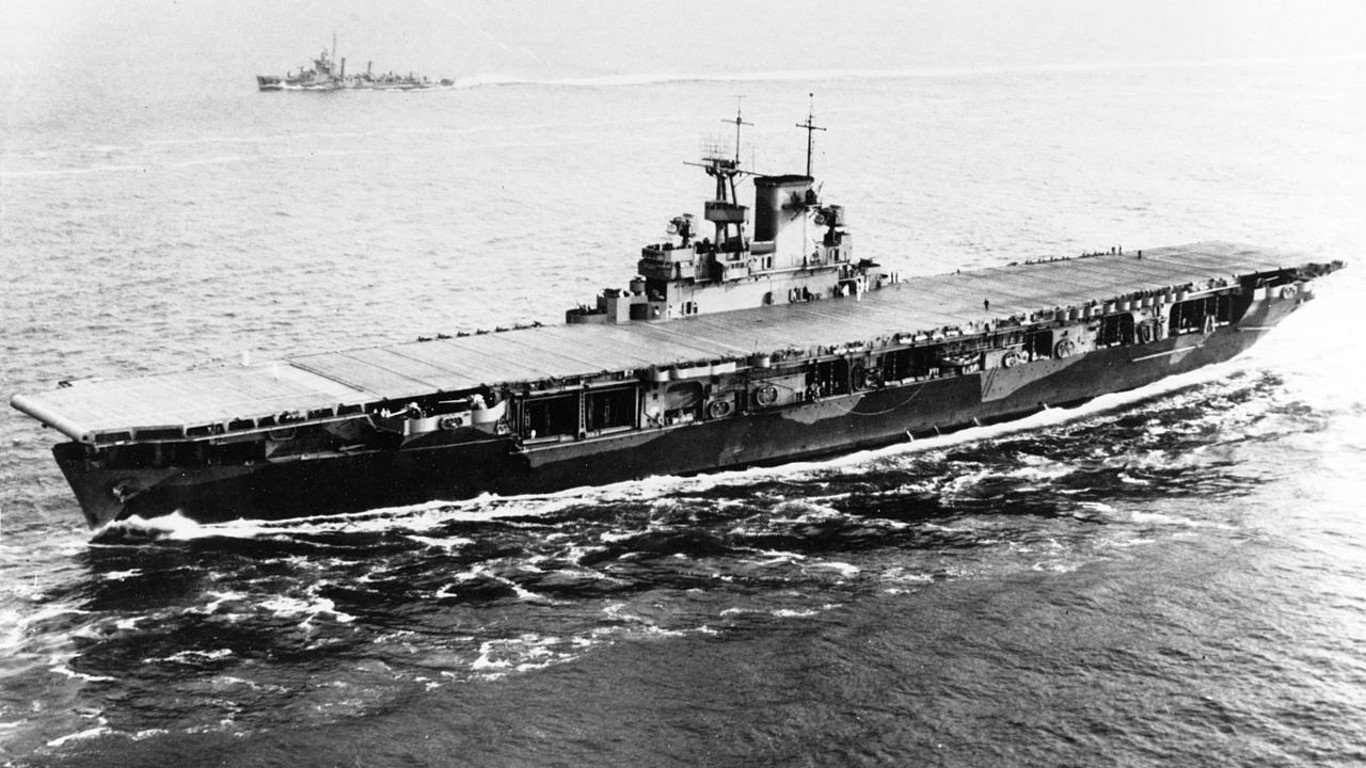
2019: USS Wasp
> Year lost: 1942
> Location where found: Off Guadalcanal
> Found by: Team led by Microsoft co-founder Paul Allen
Paul Allen’s R/V Petrel, a research vessel that’s found dozens of shipwrecks, added the hull of the USS Wasp, an aircraft carrier sunk by Japanese torpedoes in 1942 off Guadalcanal, to its list of discoveries. The wreck was found at a depth of 14,000 feet. Most of the officers and enlisted men on the USS Wasp were rescued by U.S. Navy ships.
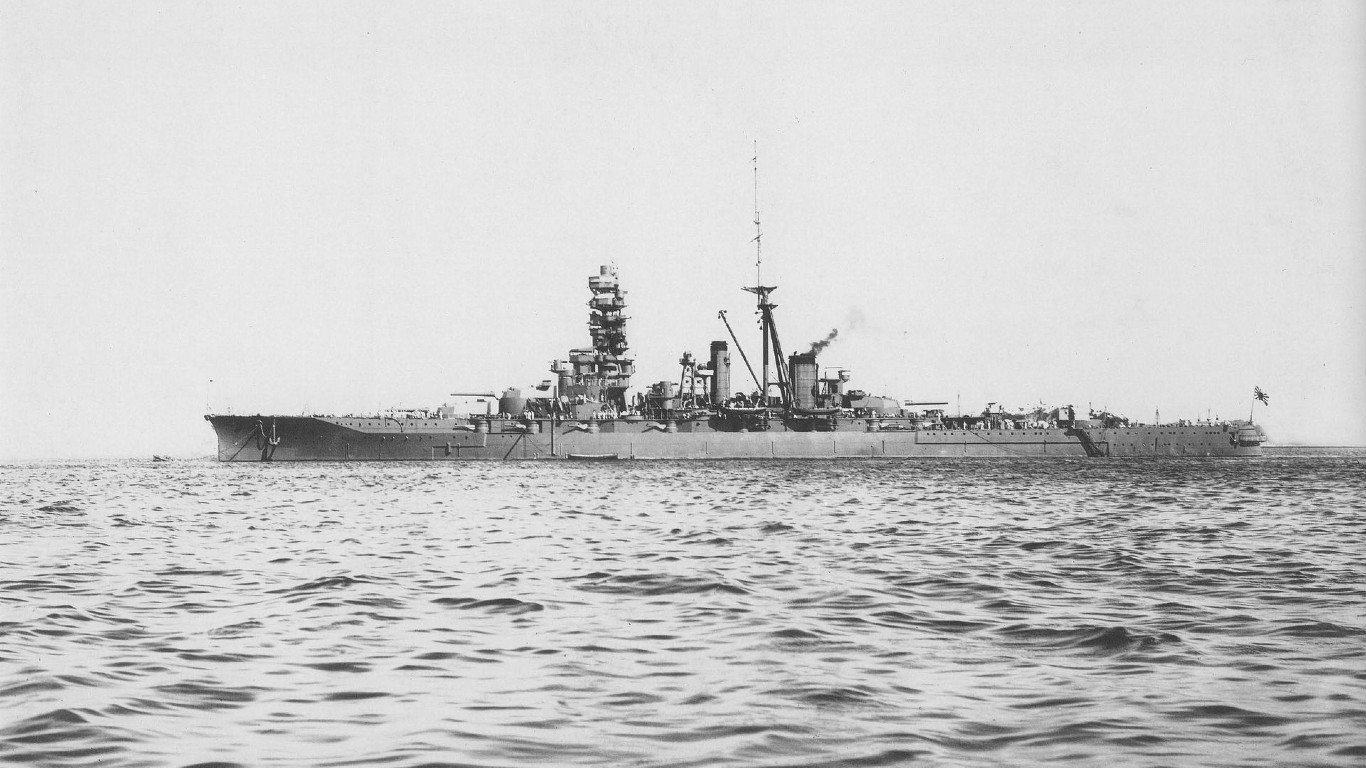
2019: Hiei
> Year lost: 1942
> Location where found: Off of Guadalcanal
> Found by: Team led by Microsoft co-founder Paul Allen
During the same battle that claimed the USS Juneau, the Japanese battleship Hiei was sunk. The 31,000-ton ship was the first Japanese battleship sunk by the U.S. Navy during World War II. It was discovered by researchers aboard Paul Allen’s R/V Petrel.
[in-text-ad]
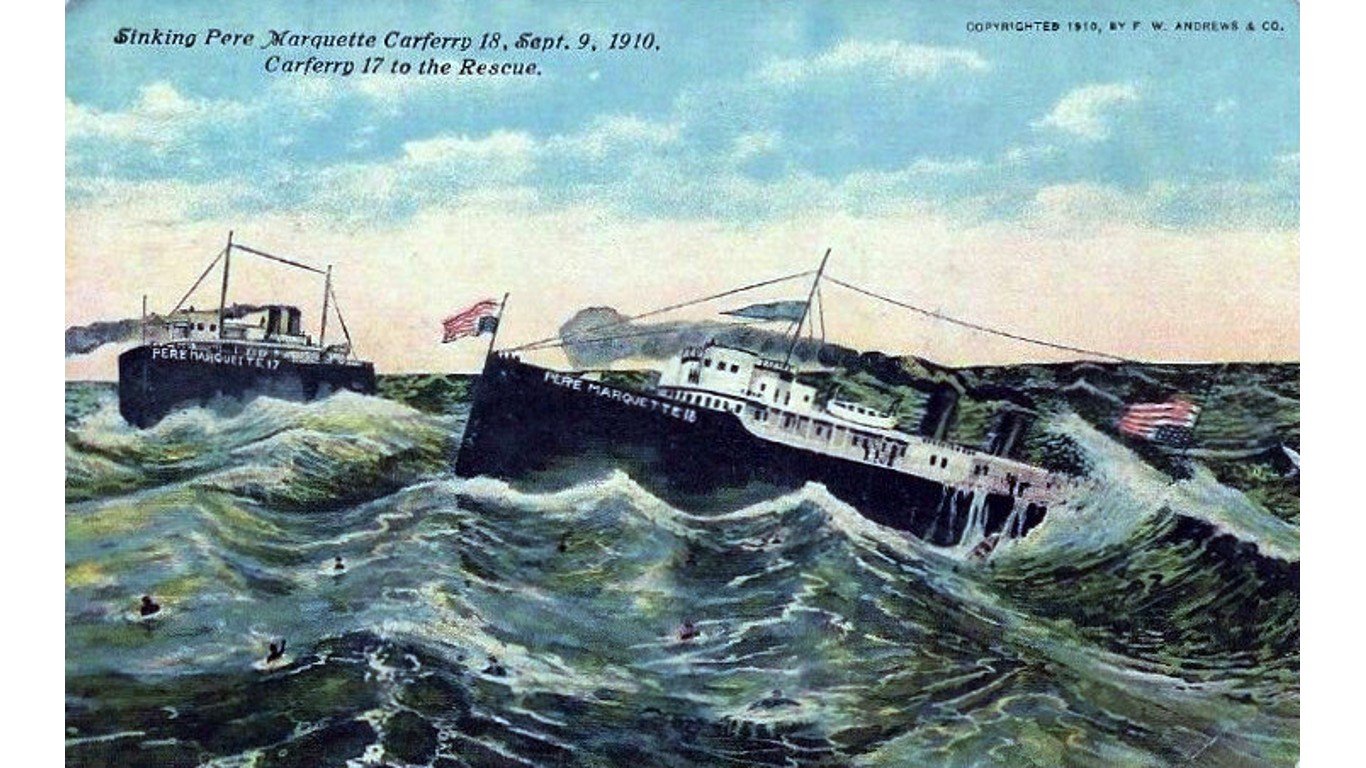
2020: SS Pere Marquette 18
> Year lost: 1910
> Location where found: Lake Michigan off Sheboygan, WI
> Found by: Two Minnesota shipwreck hunters
Pere Marquette 18, a transport ship carrying about 60 passengers and crew and 30 rail cars on Lake Michigan from Ludington, Michigan, to Milwaukee, sank offshore from Sheboygan on the morning of Sept. 9, 1910, killing 29 people. Its wreck eluded discovery for a century until 2020 when Minnesota shipwreck hunters Jerry Eliason and Ken Merryman located it in nearly 500 feet of water off Sheboygan and Port Washington, Wisconsin.
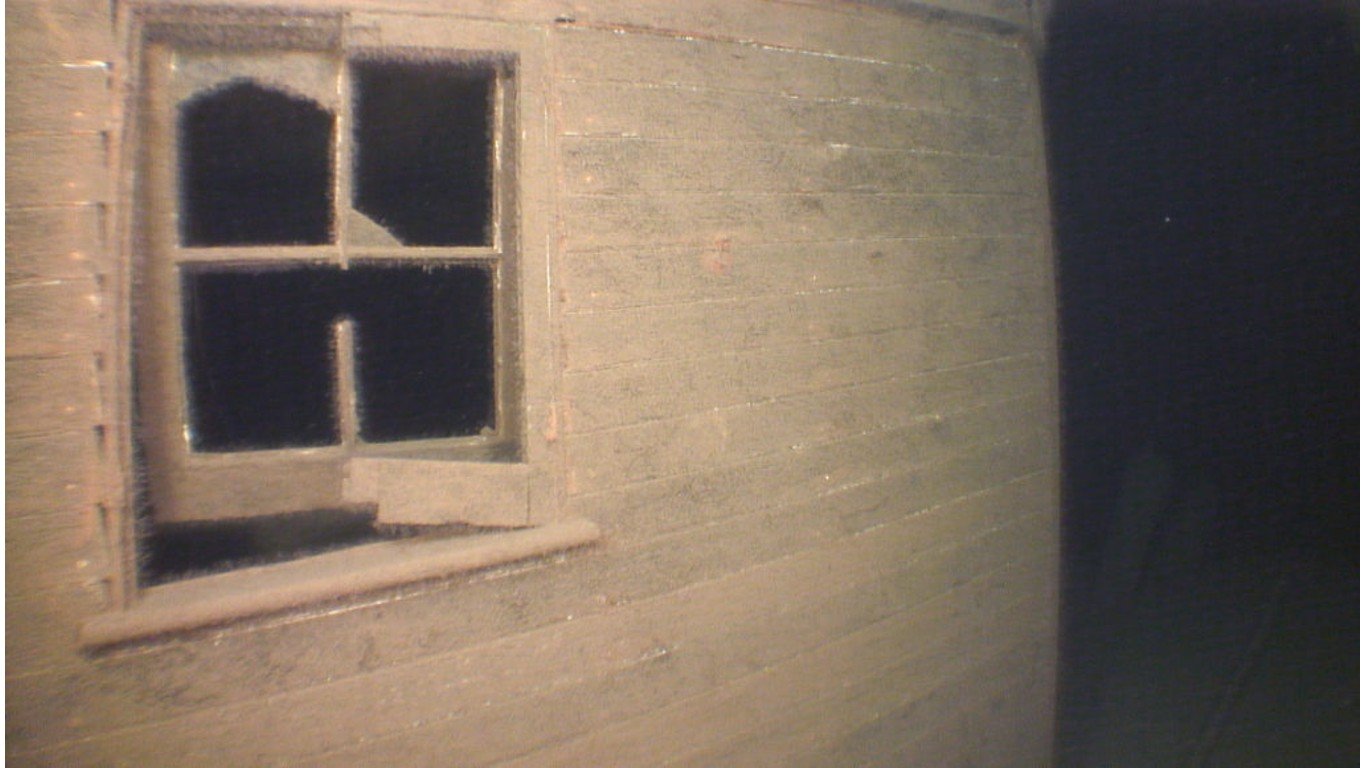
2021: Frank W. Wheeler
> Year lost: 1885
> Location where found: Near Grand Island, Lake Superior, MI
> Found by: Researchers for the Great Lakes Shipwreck Historical Society
Frank W. Wheeler, a schooner-barge, was being towed by the steamer Kittie M. Forbes on Sept. 29, 1885, when a gale blew across Lake Superior. Conditions worsened and the Wheeler began to sink. William Forbes, owner and captain of the Wheeler, ordered his men into the lifeboat, and 15 minutes later the ship sank. It was found in the summer of 2021 by researchers for the Great Lakes Shipwreck Historical Society near Grand Island in 600 feet of water.
2022: Endurance
> Year lost: 1915
> Location where found: Weddell Sea, Antarctica
> Found by: Falklands Maritime Heritage Trust
The Endurance, the lost vessel of Antarctic explorer Sir Ernest Shackleton, was discovered at the bottom of the Weddell Sea in March. The ship was crushed by sea ice and sank in 1915, forcing Shackleton and his men to escape on foot and in small boats. All of the crew survived the ordeal. The demise of the ship was chronicled by filmmaker Frank Hurley. The Endurance was found by the Falklands Maritime Heritage Trust. The wreck is a designated monument under the international Antarctic Treaty and is not to be disturbed. No physical artifacts have been brought to the surface.
Take This Retirement Quiz To Get Matched With A Financial Advisor (Sponsored)
Take the quiz below to get matched with a financial advisor today.
Each advisor has been vetted by SmartAsset and is held to a fiduciary standard to act in your best interests.
Here’s how it works:
1. Answer SmartAsset advisor match quiz
2. Review your pre-screened matches at your leisure. Check out the
advisors’ profiles.
3. Speak with advisors at no cost to you. Have an introductory call on the phone or introduction in person and choose whom to work with in the future
Take the retirement quiz right here.
Thank you for reading! Have some feedback for us?
Contact the 24/7 Wall St. editorial team.

 24/7 Wall St.
24/7 Wall St.

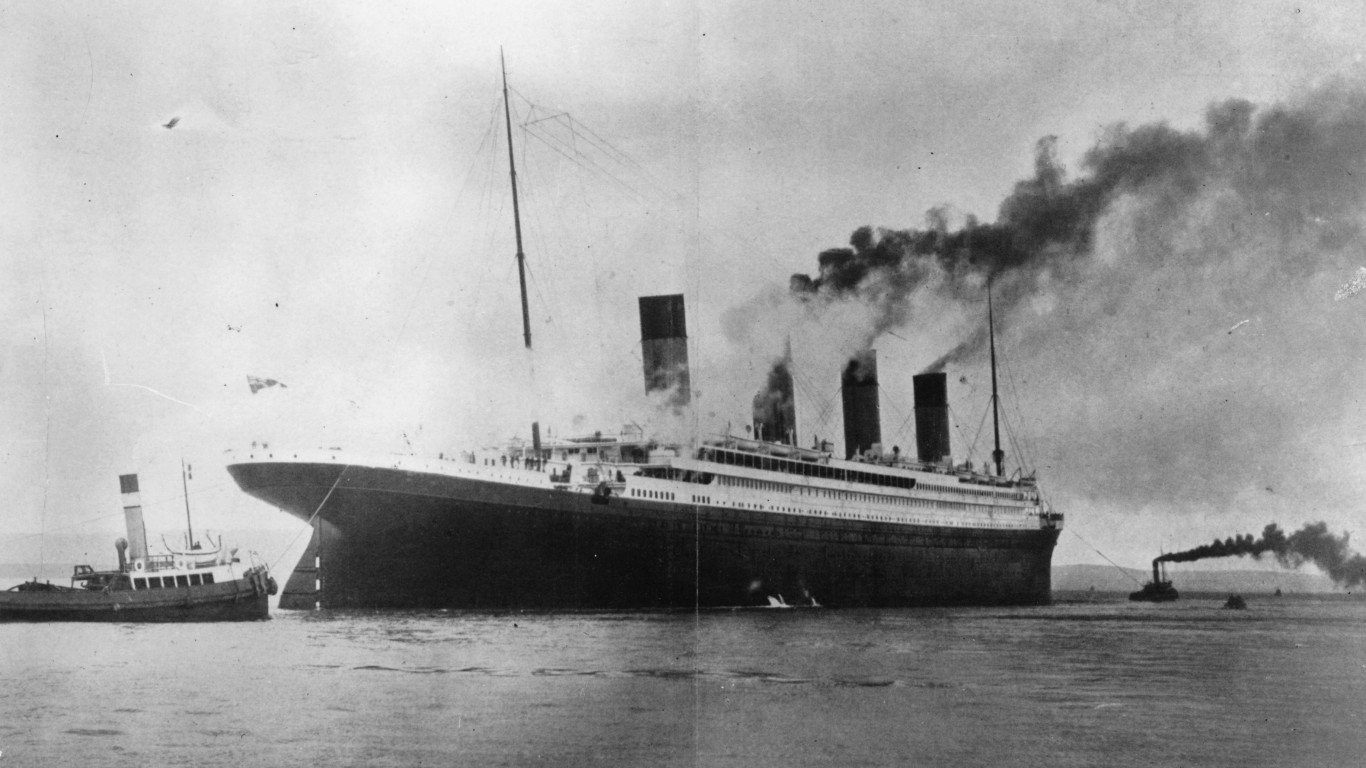 24/7 Wall St.
24/7 Wall St.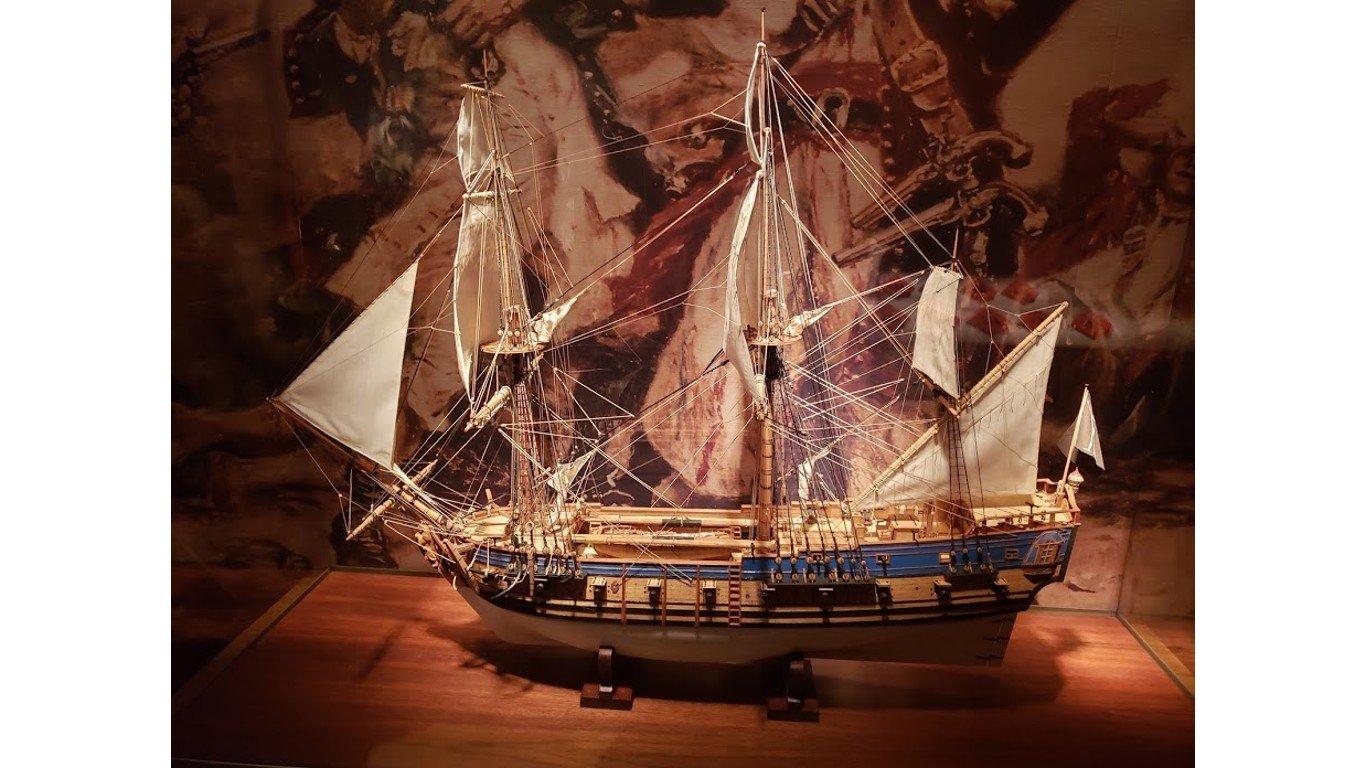
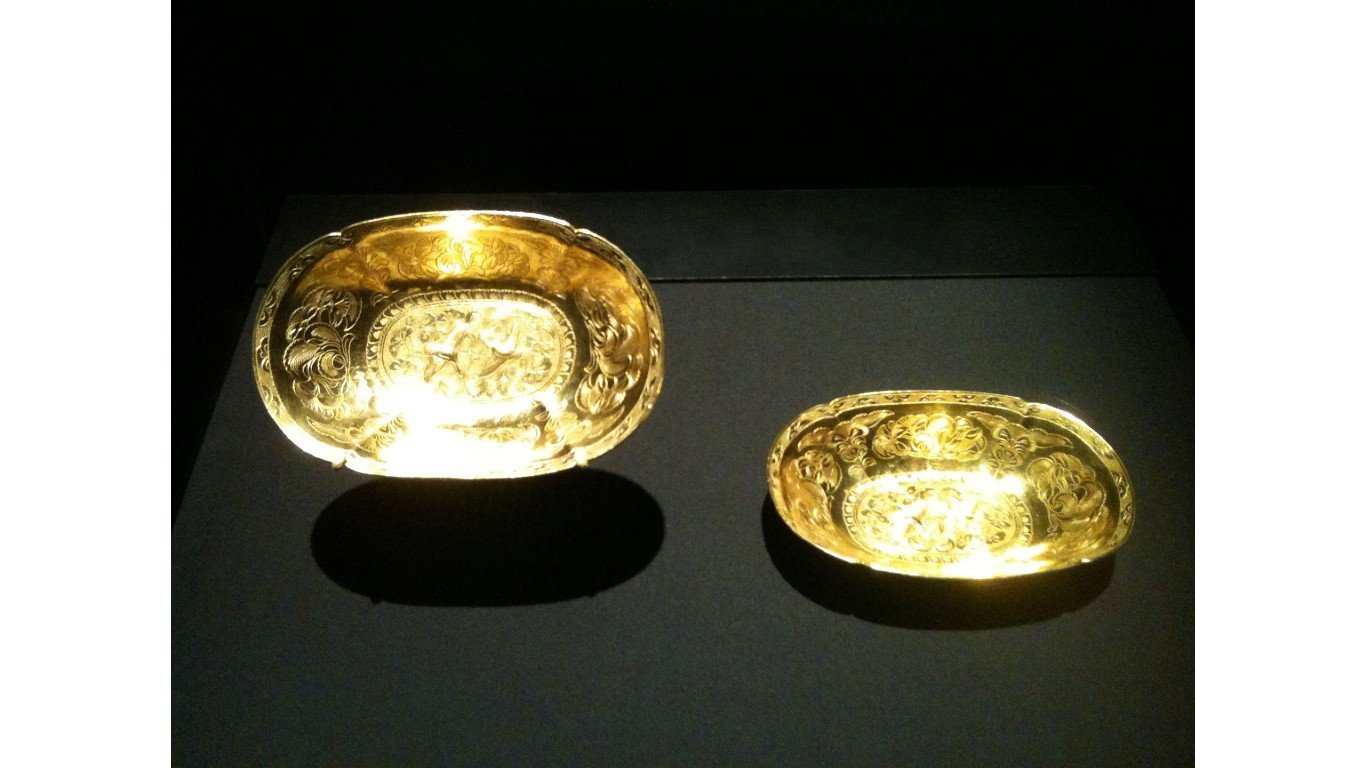
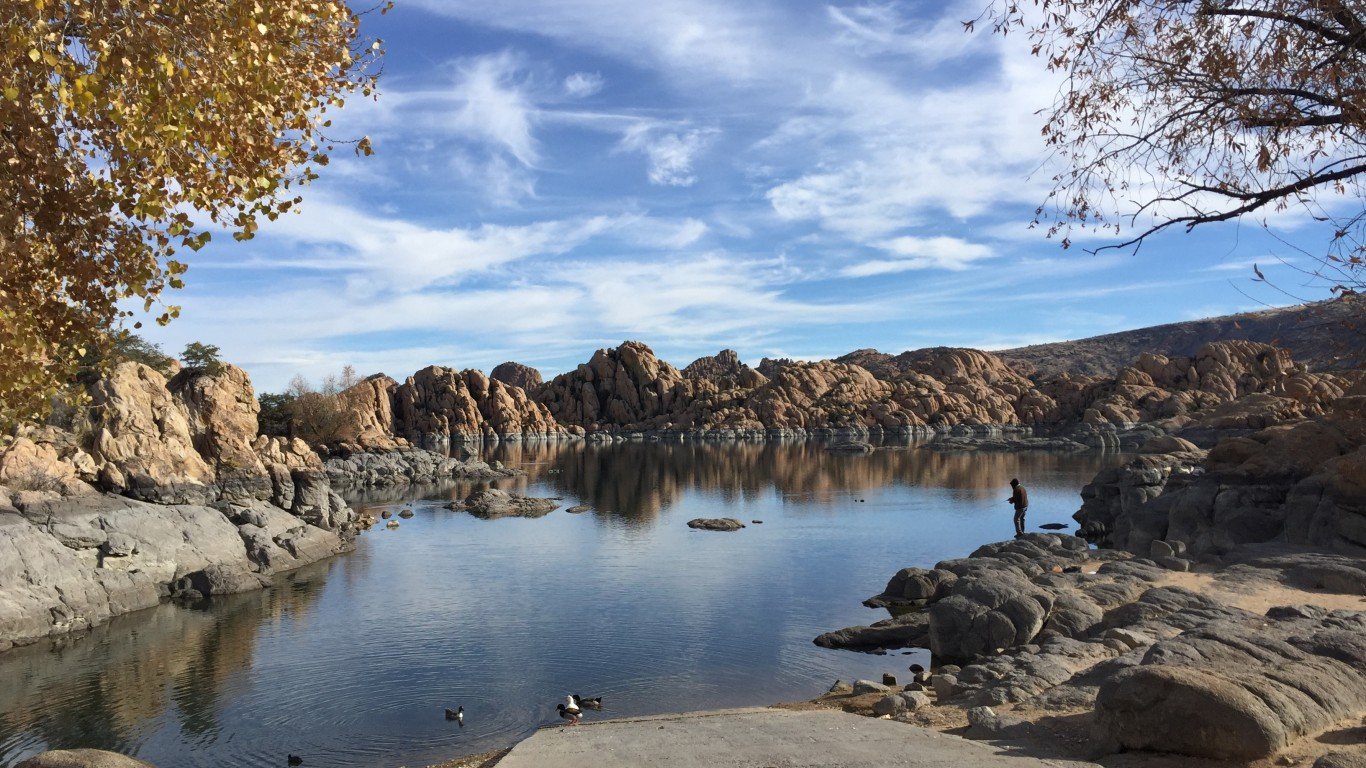 24/7 Wall St.
24/7 Wall St.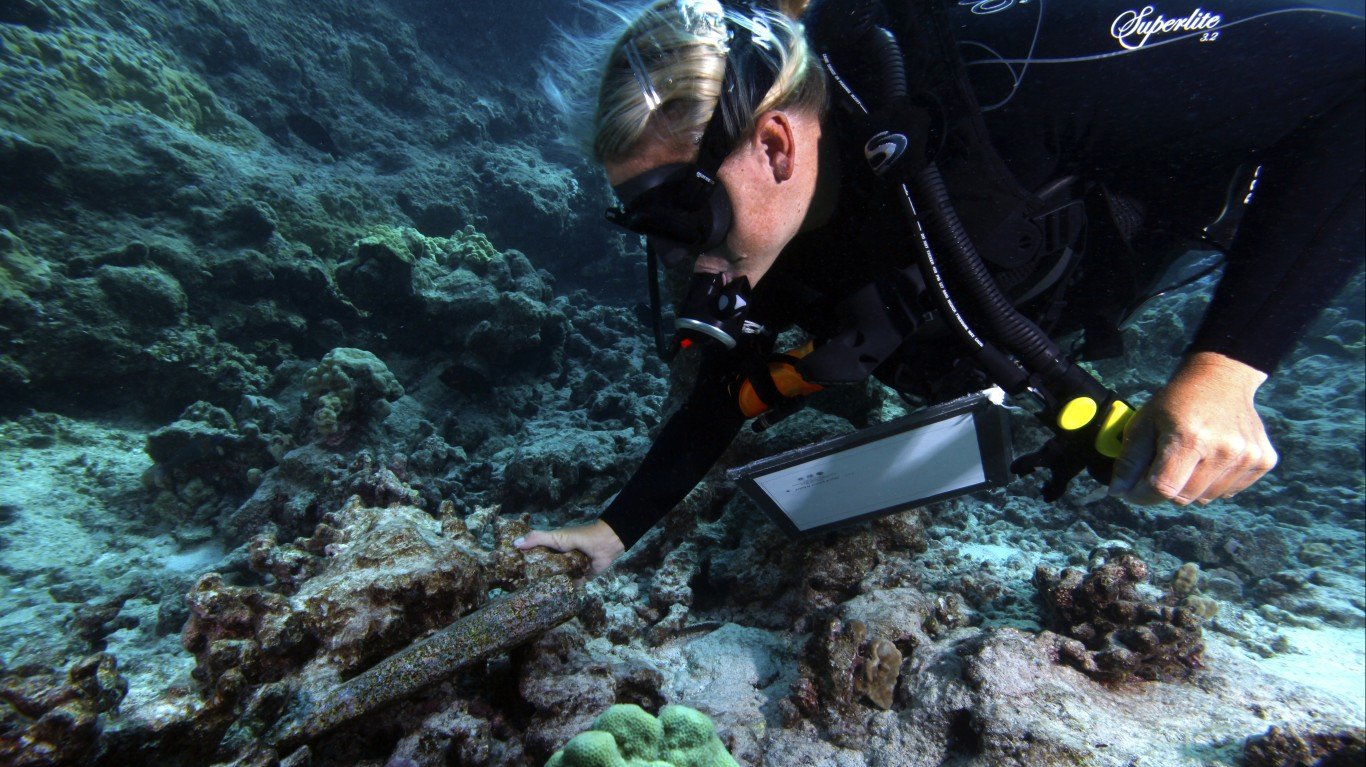
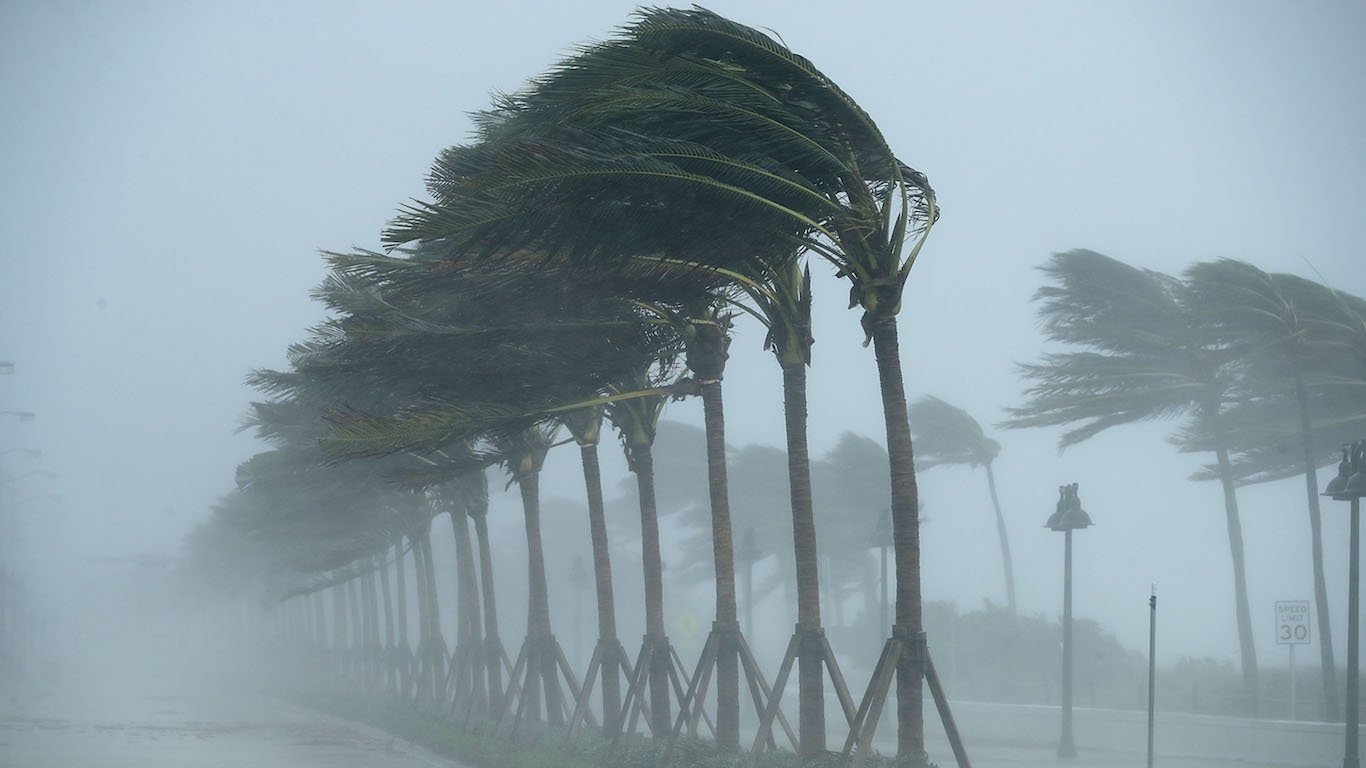 24/7 Wall St.
24/7 Wall St.